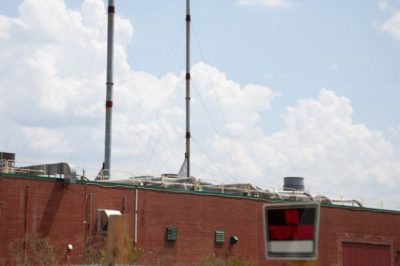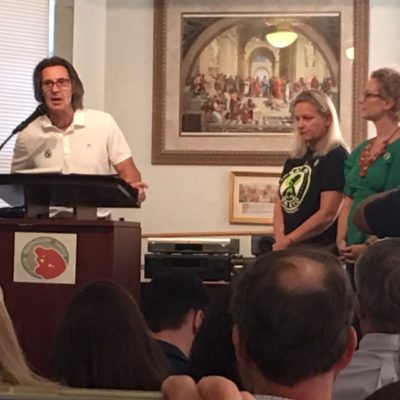Brenda Goodman is senior news writer for WebMD. Andy Miller is the editor and CEO of Georgia Health News.
Twilight was falling, but the heat would not let up.
Cars packed the tiny parking lot of a historic red brick building that sits on a corner of North Church Road in Atlanta, their tires crunching through the white gravel. When space ran out, they spilled down side streets and into the lots of neighboring businesses, whose employees and customers were long gone for the day.
People approached solemnly.
“Where do you live?” they asked each other. Then, after a nod of recognition, “I’m sorry.”

They came from the mansions that overlook the Chattahoochee River. They came from brand-new, freshly painted townhomes. They came from apartment communities and single-family homes. Some had just moved here. Some had lived here for years. Some were trying to sell their homes and leave.
Now they were stuck with the same problem: dirty air.
Everyone was struggling to absorb news that broke last week that state and federal environmental regulators had flagged certain neighborhoods in the area as having higher cancer risks because of a toxic gas called ethylene oxide. In the Smyrna area, which straddles the line between Cobb and Fulton counties, the ethylene oxide comes from a plant run by Sterigenics, which uses the gas to sterilize medical products and supplies, drugs and spices.
For decades, the small building where they gathered was a church, its walls ringing with the exhortations of Baptist preachers. But the church was eventually sold to the Atlanta Freethought Society, a secularist organization.
On Wednesday, the society waived the $75 rental fee so that the community could gather to hear Margie Donnell, a real estate attorney and mom from suburban Chicago, who, with her neighbors, has been fighting a Sterigenics plant where she lives.
Donnell’s friend and fellow activist, Neringa Zymancius, flew in from Illinois to join her in speaking to the Georgia group, which had lately inundated their Stop Sterigenics Facebook page with questions.
Tony Adams, a massage therapist who lives in the Smyrna area and has taken on the task of trying to turn the worries and anger of his neighbors in recent days into community action, joined Donnell and Zymancius at the podium.
People squeezed into every available seat. When space in the pews and chairs ran out, they stood against the walls and sat in the aisles.
For more than 2 hours, they leaned forward as they sat in heat that approached 90 degrees, red-faced and rapt. Some took notes in the margins of news stories they’d printed from their computers.
Before they started, the Illinois visitors turned around to show the size of the crowd and sent live video to the Stop Sterigenics Facebook page.
“Thanks for being here tonight,” Adams said. “I wish we didn’t have to be here.”

Bracing his arms on both sides of the podium, he explained to the crowd that he grew up in the small Georgia town of Fort Valley, which was polluted by the Woolfork Chemical Works. The plant was right next to his parents’ shop.
“You could smell the chemicals every day,” he said, his voice choking up.
When he was 16, he said, “I watched my mom suffer and die from cancer at 52.”
Adams said he’d also lost numerous high school friends to cancer before they were 40 or even 30 years old. “The cancer rates in my hometown were off the charts,” he said. “It took 15 years for the EPA to shut that chemical facility down and declare it a Superfund site.”
“I swore as a 16-year-old,” he said, his voice choked with emotion. “If I ever felt that I was being put in that situation again, I was not going to sit around a wait for somebody to do something.”
“I’m sorry if some of you are upset with me because of our property values,” he said. “This is bigger than North Church Lane.”
Donnell stepped up to the podium in a “Stop Sterigenics” T-shirt and white pants.
“First let me say that Neringa and I will stay here as late as you all need us to. Until the very last person has their question answered, we will not leave,” she said.
Donnell explained that although she works as an attorney, she was not at the Atlanta meeting house in a professional capacity.
“I’m a volunteer community member, part of this grassroots organization,” she said. She said she happened to be in Atlanta to visit her company’s corporate headquarters when the news of the Smyrna and Covington pollution broke.
“We all have other jobs,” she said.
Her message was blunt: Be loud. Be persistent. Get the air tested. Without independent air testing, she explained, you don’t really know what’s going on. She was girding them for battle.
“I remember the first meeting, the first town hall we had. I was sitting down just like you,” said Zymancius.
“I’m a mom. I live in Darien [a Chicago suburb]. I bought my first house. I did my research. I wanted the nicest neighborhood. In Darien, literally, the motto is ‘A nice place to live,’ ” she said.
“I looked at the water. I looked at everything. I never looked at the air.’’
“Who would sit here in America right now to think that we are being poisoned and the government is allowing this to happen?” she said.

According to reporting from the Chicago Tribune, half a million people live in census tracts that the EPA has identified as having higher-than-acceptable risks for cancer caused by ethylene oxide.
“Nobody here,” she said. “Nobody in Willowbrook. Nobody in Chicago, Nobody in Allentown, Pennsylvania. Nobody in New Orleans. Nobody in Michigan. These are all towns that are going through the same thing. We were all surprised just as you all are sitting here right now,” she said. “My bubble was burst that day.”
Now, she regularly texts with Erin Brockovich, a famous environmental activist who was the subject of a hit movie in 2000. Brockovich sent a message of support to the meeting.
“I’m with them and here for full support,” read the text. People stepped up to take photos of it.

Many people had already called or emailed the EPA and Georgia’s Environmental Protection Division. Some had spoken to doctors at ATSDR, a division of the CDC.
Most had already gotten the same kinds of answers: We’re looking into it.
In a statement Thursday, Georgia’s Environment Protection Division said it expected the EPA to impose new rules on sterilizing plants this summer. Until that happens, though, the state says it will “continue to work with both facilities on voluntary measures to further reduce ethylene oxide.”
So far, the state’s modeling results, based on self-reported emissions from the companies, show the cancer risks in Georgia apparently lower than those initially predicted by the EPA. Still, the state’s models show that both companies are exceeding the state’s annual acceptable Area Concentration (AAC), for ethylene oxide, the level at which health risks begin to rise.
In Covington, ethylene oxide concentrations around the BD plant are 17 to 97 times higher than the state’s AAC. In the Smyrna area, they are 27 to 61 times higher in neighborhoods around the Sterigenics plant.
According to the EPA, ethylene oxide causes cancer. It is most closely linked to breast and blood cancers such as leukemias and lymphomas. Long-term exposure is also tied to other brain and nervous system effects like headaches, memory loss, and numbness.
Faye Sullivan, 76, says she has lived in the area for 50 years. She moved in the same year as the moon landing. She came to the meeting because news about the chemical had suddenly recast family tragedies in a different light: Her husband died of cancer; her son had died of a brain tumor; and her daughter was just 43 when she developed breast cancer. Now she was wondering if ethylene oxide was responsible.

After stragglers had finally filed out, Donnell and Zymancius led a small group over to the Sterigenics plant, which was minutes away.
In a statement sent to WebMD and Georgia Health News, Sterigenics said. “The Sterigenics Smyrna facility already meets and outperforms all current permit and regulatory requirements today. We plan to implement additional emissions controls that would further capture and control emissions from this facility.” The company also noted that the Smyrna facility has been in operation since the 1970s.
In DuPage County, Ill., where Sterigenics is trying to reopen its plant, which has been sealed since February, a judge Wednesday put off the reopening of the plant for another month to consider legal arguments from surrounding communities.
As they stood in the glow of street lamps outside the Smyrna plant Wednesday night, the two women from Illinois posted another live video to social media.
“It is absolutely appalling that Sterigenics is here doing the exact same thing as they did in Willowbrook,” said Zymancius, staring into her phone.
“We want Sterigenics to know that we’re here now, and we’re not going away,” said Donnell.

